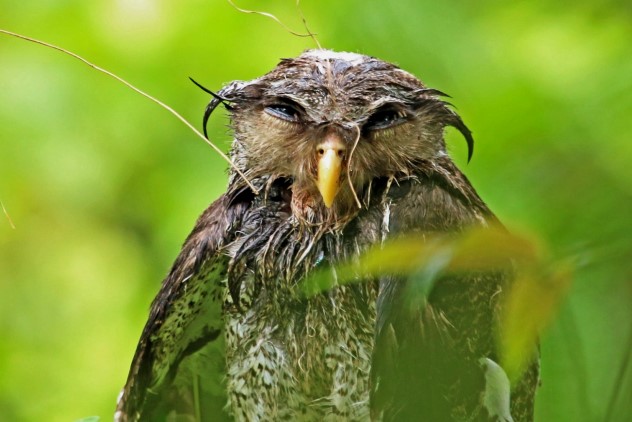I have always been fascinated by owls. I recently had my first opportunity of seeing an owl in the wild at Piasau Nature Reserve. It was a barred eagle-owl that reminds me of Yoda of The Star Wars fame.
The most striking thing about owls is their eyes. The eyes of an owl are not true eyeballs. Their tubular-shaped eyes, held in place by sclerotic rings, are completely immobile, prohibiting them from moving or rolling their eyes and providing binocular vision which fully focuses on their prey and boosts depth perception. The eyes may account for one to five percent of the owl’s body weight depending on the species. By comparison, human eyes account for about .0003% of a human’s body weight.
It is the forward facing aspect of the eyes that makes an owl look wise and also give it a wide range of binocular vision (seeing things with both eyes at the same time). Owls can thus see in three dimensions and judge distances in the same way as humans. The field of view for an owl is about 110 degrees, with about 70 degrees being binocular vision. By comparison, humans have a field of view of about 180 degrees, with 140 degrees being binocular.
The large size of the owl’s eyes allows more light to get into eyes and this can be a bit glaring during the day. Owls can see in daylight, contrary to the common misconception that owls are blind during the day. Their pupils do not shrink like human eyes in broad daylight so they partially close their eyes to block out some of the sunlight and the sky but can still see clearly the ground below.
Owls are very farsighted and cannot see objects that are too close. They use filoplumes, sensitive whisker-like bristles around their beaks, to detect objects at close range.
Owls have eyeshine, a layer of tissue behind the retina that reflects visible light. This dramatically increases the light available to the owl’s photoreceptors and gives it superior night vision.
All animal eyes (including human) have photoreceptors shaped like cones and rods. Retinal cones function best in bright light and are responsible for colour vision. Retinal rods are much more sensitive and function best in dim lights. The retina of an owl’s eye is dominated by retinal rods. These rods are very sensitive to light and movement but they do not react well to colour. An owl’s eye possesses few cone cells that react to colour, so most owls see in limited colour or in monochrome.
Owls are equipped with 3 protective eyelids. They have a normal upper and lower eyelid, the upper closing when the owl blinks, and the lower closing up when the owl sleeps. The third eyelid’ known as a nictitating membrane, is a thin layer of translucent tissue that moves horizontally across the eye, from the innr corner of the eye to the outer corner. This cleans and protects the surface of the eye.
In the pitch of darkness, owls have very efficient vision as they can pinpoint both the direction of and the exact distance from their prey. Many species of owls have ears that are not only placed asymmetrically on their head but are also different sizes. The two differently sized and placed ears receive sound at slightly different times, providing the owls with an exceptional ability to pinpoint the location of sound. When a sound is equally loud in both ears, the owl knows it has zeroed in on the source and distance. Their flattened faces funnel sound to the ears, magnifying it so that they can detect even the slightest sound from tiny prey.
Owls are known as nearly silent fliers as they need to be very quiet when swooping in on fast-moving prey. Their broad wings allow them to glide and minimize flapping, which is what creates most of the noise from a flying bird. Many species of owls have special flight feathers that minimize sound when flapping their wings. Along the leading edges of the primary flight feathers are stiff fringes that act to reduce turbulence. The wings are also covered in downy feathers to dampen sound even more.
Owls can turn their necks 135 degrees in either direction from facing forward, giving them an amazing total of 270 degrees of movement. As it is not easy to turn your head all the way to see over your shoulders, owls have some special adaptations. Instead of seven vertebrae in their necks like the average bird, owls have twice as many. They also have alternative blood vessels routing blood to the head, blood pooling systems to keep blood circulating to and from the brain when their neck movement cuts off circulation, and air-cushioned vessel casings so they don’t rupture a blood vessel when snapping their neck around 135 degrees to look over their left shoulder.
Owls are zygodactyl, having two forward-facing toes and two backward-facing toes. When perched or grasping prey, this allows an owl a better grip on prey or a branch.
Owl stomach juices are unable to dissolve bones, fur, feathers, or teeth. If these parts get into the intestines, the owl may die. All these are held in a chamber of the owl’s stomach called the gizzard. About once a day the owl’s stomach contracts, squeezing all the liquid food into the intestines, and then the owl spits up the leftover fur, bones, feathers, and teeth in a clean rounded chunk called a pellet.
Most owls don’t make their own nest. They usually nest in a tree cavity or in an old crow, raven, or hawk nest. The barred eagle-owl nests either in large tree cavities or on top of the large fern Asplenium nidus.
Didn’t I tell you that owls are amazing creatures?
 CY@CY Says Welcome to my dreamscape. Where a Lim is also a Ling.
CY@CY Says Welcome to my dreamscape. Where a Lim is also a Ling.

